|
|

by Dayanara Flores Gonzalez, age 14
Mosquitos can become immune to insect repellent over time. Mosquitos bite to harvest proteins from human blood. Research shows that mosquitos find different blood types more appetizing than others. Other studies show that it's controlled by the mosquito’s setting. Scientists discovered that 85 percent of people send a chemical signal through their skin which let mosquitos know which blood type each human has in their body.
Mosquitos locate their prey by smelling the acid, ammonia and other chemicals that are in people's sweat. Mosquitos are also attracted to people with higher body temperatures. For example, when you exercise and produce sweat this can allure mosquitos. Mosquitos also locate their targets by smelling carbon dioxide. They can detect this gas from as far as 164 feet away. People who exhale more gas over time show to attract mosquitos more than others. Different types of bacteria can affect how mosquitos react to the skin.
In a 2011 study, scientists found different types of large bacterias in human skin that attract mosquitos. However, a greater diversity of bacteria makes skin less attractive.
[read more]
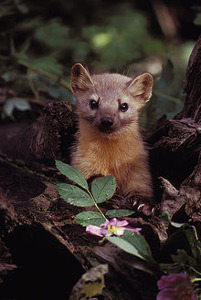
by Hiba Al-Quraishi, age 14
Pine martens are an animal species that inhabit Wisconsin, Alaska, Minnesota, Michigan, Canada, and the Rocky Mountains.
Pine martens are small and slender, weighing one to three pounds. They are approximately 15 to 24 inches long and six inches tall. Martens have big ears, a pointy face, large eyes, golden-brown fur, a yellow chest, and a long, thick tail. Females are about three-fourths the size of a male.
Pine martens are often seen in the northern parts of the state of Wisconsin and live deep in the woods. They can catch a lot of food because of their incredible climbing and fishing abilities.
[read more]

by Tierra Flowers, age 14
Scientists have found a new species of mammal—
Diegoaelurus Vanvalkenburghae
. It was a hypercarnivore which means that it exclusively ate meat. This saber-tooth tiger belonged to the animal family
Machaeroidine
as one of the first animals to have saber-like fangs. This sabertooth lived 42 million years ago in the tropical rainforest.
Only around a dozen of the fossils from the
Machaeroidine
were found. These fossils were seen in Wyoming and others were also found in Asia.
The lower jawbone of the sabertoothed animal was found in San Diego by a 12-year-old boy in the 1980s. By studying the structure of the lower jaw, scientists could identify and determine the shape and teeth of the animal.
[read more]
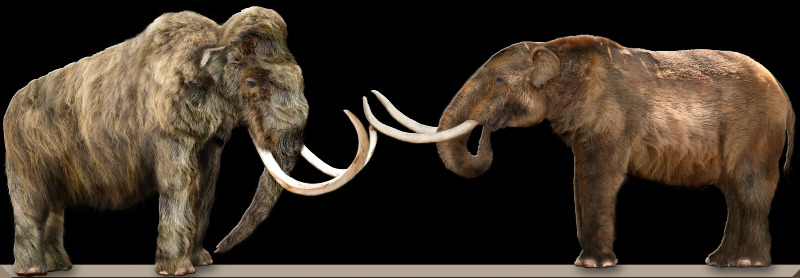
by Jeremiah Warren, age 12
Mammoths and mastodons were similar animals and today sometimes get confused with each other. Both animals had trunks and a tusk, similar to elephants today.
Until about 5,000 years ago, small populations of woolly mammoths lived on islands in the Arctic Ocean. Both mammoths and mastodons went extinct between 11,000 to 12,000 years ago.
When scientists find a skeleton, they look at the head to tell these animals apart. Mastodons had bigger heads than mammoths, while mammoths had a knob made out of bone on the top of their skulls. They both had long tusks, but mammoth tusks grew at a curve, with some even crossing in front of each other. Additionally, mastodons had much shorter and straighter tusks than mammoths.
[read more]
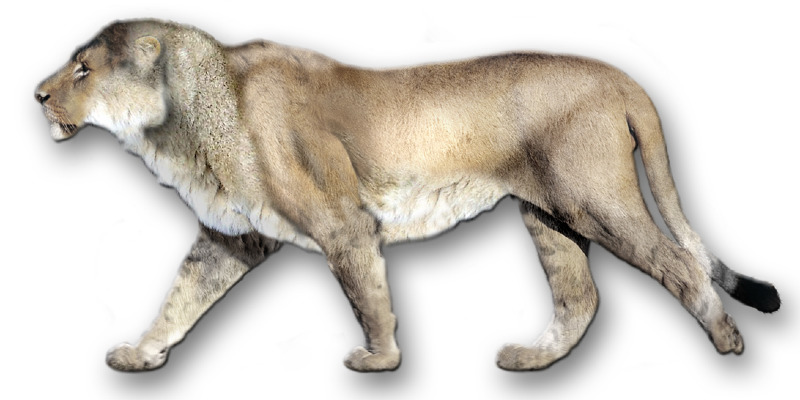
by Jessica Lopez, age 13
The American Lion is an extinct big cat that populated North America about 11,000 years ago. This is around the same time that the humans who survived the Ice Age migrated to what is now known as Wisconsin. The American lion is also referred to as the American cave lion or the North American lion. It was one of the largest cats to exist on Earth.
The American lion has some similarities to other living species in the big cat family and with another extinct species, a type of European cave lion. For this reason, scientists have had difficulty pinpointing where this species exactly originated. Researchers have conducted various studies to try to determine the relatives of the American lion. It turns out that aside from being similar to many species of big cats, such as jaguars, the American lion seems akin to several species from Asia and Africa.
Another more recent study contradicts the hypothesis of the American lion being closely related to jaguars. Ancient samples of DNA were tested and now show that this lion was most directly related to the species of extinct European cave lions along with living African lions.
[read more]

by Tierra Flowers, age 13
On March 21, 2019, researchers in Western Australia were studying orcas, a species also known as killer whales. Suddenly, the scientists witnessed a phenomenon that no one had previously seen. They observed orcas killing the world’s largest animal, a blue whale.
On that day, this group of researchers from the Cetacean Research Center were traveling on a boat to their usual orca observation site. However, when they stopped to remove some trash from the water, they suddenly noticed some splashing in the distance. They observed the dorsal fins of several killer whales and saw that they were attacking a large whale species. That whale turned out to be a blue whale.
In this attack, 12 orcas were collaborating to take down a blue whale that was between 59-72 feet long. The whale’s entire body was covered in teeth marks. Its fins were bitten off, and its face was torn apart, showing exposed bone. Some of the orcas were slamming into the whale’s sides, while others were already feasting on different body parts.
[read more]
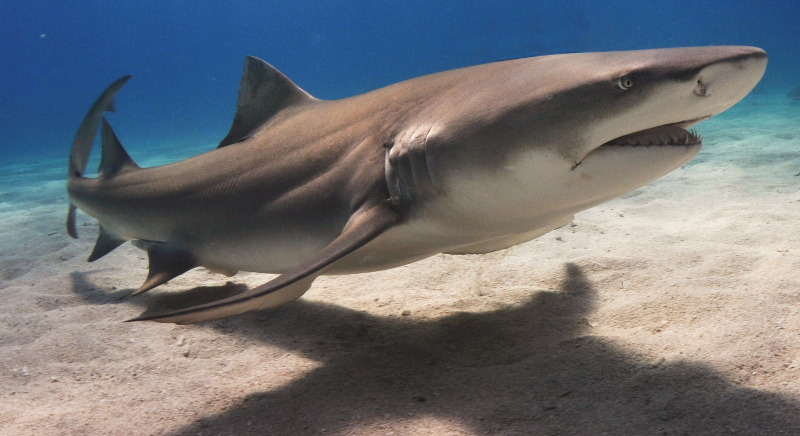
by Emily Bautista, age 13
The lemon shark is one of nearly 400 known species of sharks. Its length can be up to 10 feet and five inches, with its weight ranging between 265 to 330 pounds. The lemon shark's skin has a yellow tint, which gives the species its name. Its skin is covered in teeth-like scales known as denticles and it has the possibility to live at least 50 years.
Their usual diet is fish, including other sharks, rays, squid, and crustaceans. In fact, the lemon shark is a deadly hunter. The snouts of lemon sharks help them locate their prey by sensing electrical impulses. These sharks also have very sharp teeth that grow from the back to the front of their jaw. Their teeth are always growing to replace teeth that wear out or break.
Lemon sharks begin mating around the age of 12. Their gestation period, which is their pregnancy, usually lasts about 10 to 12 months. The breeding period for lemon sharks starts in early spring and summer. They give birth to about five to 19 pups. The lemon shark can be found on the coasts of North and South America, the Caribbean islands, and parts of the western coast of Africa.
[read more]
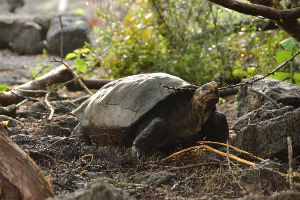
by Jessica Lopez, age 12
For nearly 100 years, scientists believed the Fernandina giant tortoise, native to the Galapagos Islands, had gone extinct. That changed when a recent expedition discovered evidence of this mysterious species on a remote island. Now, recent science is exploring how the tortoises’ population could make a comeback.
Washington Tapia, leader of the expedition, said, “For me it was the most important achievement of my life because I have been working on tortoise conservation for 30 years.” Tapia is the director of the nonprofit Galapagos Conservancy’s Giant Tortoise Restoration Initiative (GTRI) and has devoted her life to tortoise conservation.
Chelonoidis phantasticus
, more commonly known as the Fernandina giant tortoise was found by Tapia and a group of four rangers from the Galapagos National park: Jeffreys Malaga, Eduardo Vilema, Roberto Ballesteros, Simon Villama. Also involved was biologist and Animal Planet host, Forrest Galante, who funded the trip.
[read more]
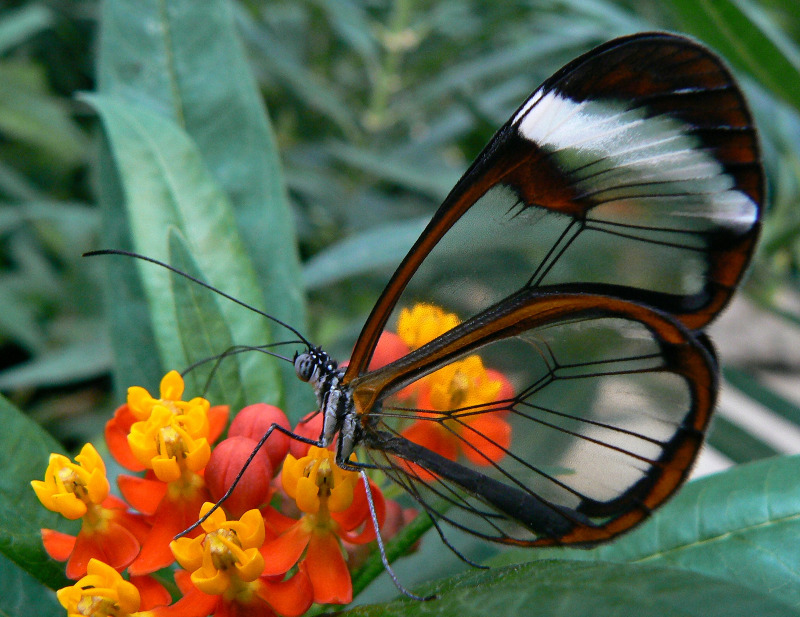
by Ayelen Flores Ruiz, age 11
Did you know there is a butterfly with see-through wings? If you haven't heard about it yet, then you are about to learn of the glasswing butterfly.
The glasswing butterfly is quite unique compared to other butterfly species. Typical butterflies have wings that are full of vibrant colors and patterns such as blue, orange, and yellow. However, the glasswing only has color on the tip of its wings.
The glasswing butterfly can be found in Latin American countries such as Mexico, Panama, and Colombia. Glasswing butterflies like to fly around rainforests. Fortunately, this species is able to fly in the rain. Their wings consist of scales that keep them from sticking together when they’re wet, giving the glasswing butterflies this special ability.
[read more]
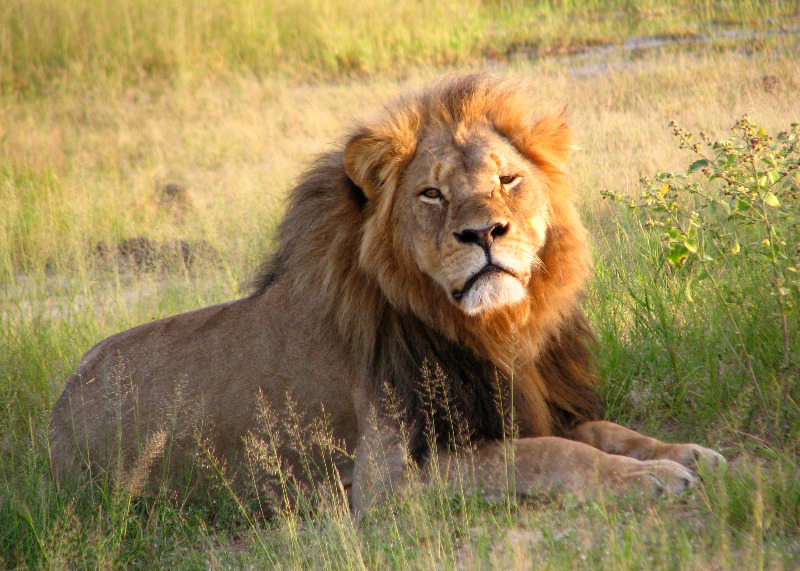
by Ayelen Flores Ruiz, age 11
Have you ever wondered what a lion's life is like? Lions spend much of their time hunting for food. These furry cats also live and raise their cubs in prides.
A male and a female lion look very different from each other. Male lions have sandy-colored fur that blends into their grassland habitat. They also have a mane of darker hair that makes them look powerful and dangerous. Female lions have sandy-colored fur too, but they do not have a mane.
The lionesses, or female lions, are responsible for hunting. They hunt as a team, which allows them to kill giant animals, such as zebras, wildebeests and buffalo. They usually hunt in the morning and evening. They do this so they can blend in with their surroundings, which makes it easier to sneak up on their prey. Most lions don't eat people, but they have done so in the past.
[read more]
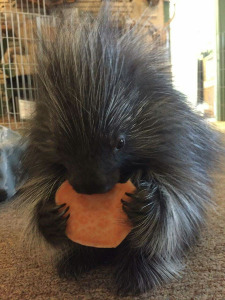
by Destiny Flowers , age 13
Roaming around the boarder of the Kalahari Desert in the South of Africa lives the Cape Porcupine. In underground burrows, unless scavenging for food, it enjoys relief of the scorching hot sun and the protection of predators.
This Porcupine is a rodent, so its two front teeth are constantly growing. In order to keep its front teeth a reasonable size, it feeds on roots, bark, herbs and fruit. In order to find these foods, it uses its keen sense of smell. This porcupine needs water like any other living thing, so it gets it from a succulent plant.
A mother porcupine usually has one or two babies. Newborns are usually 12 ounces and are very energetic. Their quills are still soft and not fully developed. They stay in the burrow under their parents’ protection. The parents groom the young porcupines by licking them and escort them to feeding in a single-file line. The young stay suckling to six to eight weeks before they are able to find their own food. They are able to eat hard solid food at two or three weeks after birth.
[read more]
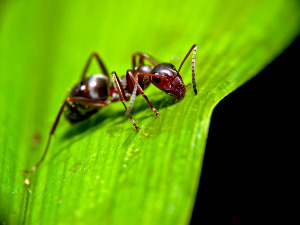
by Camila Cruz, age 11
Many ant species form
symbiotic
relationships with plants.
Symbiotic
means that both the plant and the ant benefit from being together.
These plants make nectar for ants to eat, and grow hollow thorns for the insects to live in. This proves beneficial to the plant, because ants eat the plant’s fruit and spit the seeds somewhere else so they can grow. So, the plants grow and the cycle continues. But, scientists are not sure how or when this relationship between plants and ants first began.
[read more]
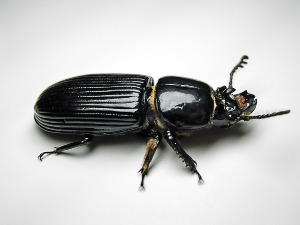
by Jeaven Nevaeh Turner, age 13
What if an insect known to be disgusting to many people, could be some of the most helpful creatures to the world? That insect is a beetle; not just any beetle but a DUNG BEETLE, also referred to as the “clean up crew”.
Around the world, there are many different types of beetles: some may help people and some may not. Some beetles have fold up wings, horns and jaws. Some just have the love for consuming droppings from cows, buffalo, elephants, and other animals.
There are at least 300,000 species of beetles and every single one of those species are different and live in different parts of the world.
[read more]
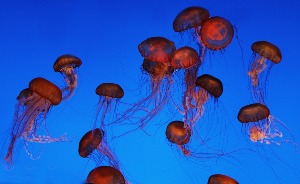
by Melanie Sanchez, age 11
When most people think of deadly sea creatures, they most often think about sharks. However, sharks rarely attack humans. There are other sea creatures that can kill people.
A blue-ringed octopus is usually smaller than a human hand. Although it seems quite harmless, one bite from this creature can kill. Even though its bite is painless, it can be fatal in just a few seconds. A human can become paralyzed and stop breathing.
Sea snakes are mostly found in the coral reef waters of the Pacific and Indian oceans. They hunt for their prey which hides in coral crevices or sandy burrows. One bite from these creatures can be as deadly as a cobra's bite. Most sea snakes will not attack humans unless they are provoked. The people who are most often killed by sea snakes are fishermen.
[read more]
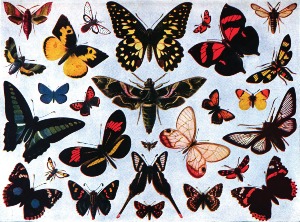
by Zaniya Richardson, age 12
Butterflies and are some of the sky's most beautiful and colorful creatures, and although they might not seem all that special, they are. People are often surprised by the secrets these tiny insects hold.
During their earlier stages, butterflies and moths are caterpillars. Some caterpillars are poisonous, similar to how their older selves can be. Caterpillars build cocoons around themselves and then turn into butterflies and moths inside. This process is called metamorphosis.
Butterflies and moths do not have mouths to eat. Instead they have tubes. The tube is called a proboscis. These tubes are flexible allowing them to move to the blossom. The butterflies and moths extend their feeding tubes into the blossoms and extract the nectar. This is their food source. To these insects, blossoms are sweet and delicious, even though to humans nectar is bitter.
[read more]
Not only are owls pretty to look at but they are important to the environment. Wisconsin is lucky to have just the right climate and pool of available prey to attract these fascinating creatures.
[read more...]
Mosquitos can become immune to insect repellent over time. Mosquitos bite to harvest proteins from human blood. Research shows that mosquitos find different blood types more appetizing than others. Other studies show that it's controlled by the mosquito’s setting. Scientists discovered that 85 percent of people send a chemical signal through their skin which let mosquitos know which blood type each human has in their body.
[read more...]
Scientists have found a new species of mammal—Diegoaelurus Vanvalkenburghae. It was a hypercarnivore which means that it exclusively ate meat. This saber-tooth tiger belonged to the animal family Machaeroidine as one of the first animals to have saber-like fangs. This sabertooth lived 42 million years ago in the tropical rainforest.
[read more...]
Pine martens are an animal species that inhabit Wisconsin, Alaska, Minnesota, Michigan, Canada, and the Rocky Mountains.
Pine martens are small and slender, weighing one to three pounds. They are approximately 15 to 24 inches long and six inches tall. Martens have big ears, a pointy face, large eyes, golden-brown fur, a yellow chest, and a long, thick tail. Females are about three-fourths the size of a male.
[read more...]
Mammoths and mastodons were similar animals and today sometimes get confused with each other. Both animals had trunks and a tusk, similar to elephants today.
Until about 5,000 years ago, small populations of woolly mammoths lived on islands in the Arctic Ocean. Both mammoths and mastodons went extinct between 11,000 to 12,000 years ago.
[read more...]
El tiburón limón es una de las casi 400 especies conocidas de tiburones. Su longitud puede ser de hasta 10 pies y cinco pulgadas, con un peso entre 265 y 330 libras. La piel del tiburón limón tiene un tinte amarillo, lo que le da su nombre a la especie. Su piel está cubierta de escamas parecidas a dientes conocidas como dentículos y tiene la posibilidad de vivir al menos 50 años.
[read more...]
Un manatí es un animal acuático que es grande y de movimiento lento que vive en Florida. Desafortunadamente, estas criaturas se están extinguiendo.
[read more...]
El tiburón limón es una de las 400 especies conocidas de tiburones. Su longitud puede ser de hasta 10 pies y cinco pulgadas, con su peso que es entre 265 y 330 libras. La piel del tiburón limón tiene un tinte amarillo, es lo que le da la nombre a la especie. Su piel está cubierta de escamas parecidas a dientes conocidas como dentículos y tiene la posibilidad de vivir al menos 50 años.
[read more...]
The lemon shark is one of 370 species of sharks. Its length can be up to 10 feet and five inches, with its weight ranging between 265 to 330 pounds. The lemon shark's skin has a yellow tint, which gives the species its name. Its skin is covered in teeth-like scales known as denticles and it has the possibility to live at least 50 years.
[read more...]
Did you know there is a butterfly with see-through wings? If you haven't heard about it yet, then you are about to learn of the glasswing butterfly.
[read more...]
You may have heard the phrase “blind as a bat.” This phrase is very misleading as bats are not blind. Many people don’t know much about bats and there are plenty of misconceptions surrounding these unusual species.
[read more...]
For nearly 100 years, scientists believed the Fernandina giant tortoise, native to the Galapagos Islands, had gone extinct. That changed when a recent expedition discovered evidence of this mysterious species on a remote island. Now, recent science is exploring how the tortoises’ population could make a comeback.
[read more...]
A mammal is a vertebrate animal that produces milk to feed their young. There are mammals that live on land, air and water. A few examples of unique mammals that live in different places of the world are foxes, bats, and dolphins.
[read more...]
Have you ever wondered what a lion's life is like? Lions spend much of their time hunting for food. These furry cats also live and raise their cubs in prides.
[read more...]
Roaming around the boarder of the Kalahari Desert in the South of Africa lives the Cape Porcupine. In underground burrows, unless scavenging for food, it enjoys relief of the scorching hot sun and the protection of predators.
[read more...]
Did you know that when cows burp or fart they release a gas called methane that is toxic for our atmosphere? When scientists added seaweed in small amounts to the diet of a group of cows, the cows showed a reduction in the release of methane.
[read more...]
Do you know how clever and smart beavers are? They work as if they were architects, builders, and farmers all in one!
[read more...]
What if an insect known to be disgusting to many people, could be some of the most helpful creatures to the world? That insect is a beetle; not just any beetle but a DUNG BEETLE, also referred to as the “clean up crew”.
[read more...]
Many ant species form symbiotic relationships with plants. Symbiotic means that both the plant and the ant benefit from being together. But, scientists are not sure how or when this relationship between plants and ants first began.
[read more...]
Butterflies and are some of the sky's most beautiful and colorful creatures, and although they might not seem all that special, they are. People are often surprised by the secrets these tiny insects hold.
[read more...]
This year the WBAY television news station in Green Bay announced a bobcat sighting. The big cat was spotted in Suamico Wisconsin, near Highway 41.
[read more...]
When most people think of deadly sea creatures, they most often think about sharks. However, sharks rarely attack humans. There are other sea creatures that can kill people.
[read more...]
The lesser long-nosed bat is no longer endangered thanks to conservation made possible by scientists and volunteers. It is the first U.S. bat to escape endangerment. The bats' recovery is thanks to cooperation between the United States and Mexico.
[read more...]
Spiders come in many shapes and sizes. Some spiders are well known and some are seen as a threat. Without spiders, the population of many annoying bugs would be larger. As long as they are not bothered, spiders don't pose a serious threat to most animals or people.
[read more...]
Recent developments have uncovered huge termite mounds completely covering a vast area in northeastern Brazil, previously covered by thick forests. These masses of earth can be up to three meters tall, and up to ten meters wide. They cover an area roughly the size of England. The combined mass of all the mounds can be seen from low earth orbit, though it is difficult to see individual mounds from that height.
[read more...]
Mule deer can be found from central Mexico to northwestern Canada. They can also be found to inhabit land as far east as Kansas and Nebraska. In these areas, buildings are being constructed which is causing habitat loss.
[read more...]
Vilavu is a young female mountain gorilla that lives in Virunga National Park in the Democratic Republic of the Congo, an African country. In this National Park, the mountain gorillas live in separate family groups called troops. Almost all gorillas love to play, but each troop has their own set of rules to follow.
[read more...]
Have you ever heard of the Iguanodon, one of the first dinosaurs ever discovered, that roamed the land during prehistoric times? Well, if you want to learn more about this great herbivore, read on.
[read more...]
Native bee populations are declining. They are being threatened by urbanization and new farming techniques which can both poison the bees and harm their food source. Yet, there are ways that communities and individuals can help the bees.
[read more...]
Narwhals are often referred to as the unicorns of the sea. Much like unicorns, narwhals live a mysterious life, deep in the Arctic ocean.
[read more...]
Cheetahs are as fast as cars. They are able to go up to 70 mph for short distances, and they can reach their maximum speed in just 3 seconds!
[read more...]
Sloths are usually seen as unique creatures, especially the recently discovered pygmy three-toed sloth. Living in one distinct area, it’s now labeled “critically endangered”.
[read more...]
Social insects, Earth´s strong little creatures, are a triumphant group of animals. It is no surprise why many people are so fascinated by their astonishing capabilities.
[read more...]
Measuring up to 20 feet long and measuring up to 7,040 pounds, the great white shark has supposedly been around for many millennia. Yet, this mammal it kills fewer people than bees do. So why does the great white shark have such a reputation as a ferocious killer?
[read more...]
The majority of woolly mammoths went extinct 10,600 years ago when climate change caused their supply of drinking water to dry up. Scientists analyzed climate change and came to the conclusion that global warming likely led to the shallow waters responsible for the animal's demise.
[read more...]
In 2018 researchers have not seen baby North Atlantic whales in the Atlantic Ocean from Florida to Georgia where they are usually found. Where could these baby whales be?
[read more...]
Over the years, many animal species have gone extinct: meaning there’s not a single one alive today. Will vaquitas be next?
[read more...]
Many aquatic species struggle to live in underwater conditions. Clownfish however, are excellent at using their strengths to survive the harsh conditions of the sea.
[read more...]
One of the most common animals in the world is pigs. Though they have a reputation for being among the filthiest of creatures, pigs are actually quite clean. Many people assume pigs are dirty because these mammals cool themselves off by rolling around on the ground; however, when pigs are in a cool environment, they stay cleaner than one might imagine. Overall, pigs are unique animals with many fascinating traits.
[read more...]
Many people are used to seeing icicles hanging from tree branches, but some might now know that icicles also exist beneath the ocean. These underwater icicles,
brinicles
, are also referred to as “sea stalactites” because of their unique in-water formation.
[read more...]
Paramecia are microscopic, single-celled living organisms shaped like slippers. They are found in fresh lake water and have the fascinating ability to shoot out poison darts called
trichocysts
to wound and capture their prey.
[read more...]
Recent studies involving 3-D glasses reveal a perhaps surprising truth: praying mantises have depth perception.
[read more...]
African elephants' teeth are just as important to them as their hearts or any other major organs are, according to veterinary dentist David Fagan. Without their teeth, these massive mammals would certainly die.
[read more...]
For some, Jamaican coffee is a staple. Whether it helps you wake up at the crack of dawn or it complements your afternoon doughnut, the world seems to run on coffee. Unfortunately, Jamaican coffee has been in decline for years. But there just might be hope for Jamaican coffee farmers and lovers, in the surprising form of birds.
[read more...]
The fact that giraffes have long necks is commonly known. But what might surprise some people is that it wasn't always this way, and there are many theories why.
[read more...]
There are many fascinating animals living in Africa, but the most interesting to me are giraffes and elephants.
[read more...]
Eurasian Woodcocks are great, wondrous creatures with many interesting quirks and features. But the real question is, can you find them?
[read more...]
African elephants are massive, majestic creatures; unfortunately, however, they are also endangered. African elephants are getting shot and killed every day for their ivory in their tusks. Ivory is sold all around the world as a luxury item. Elephants are also hunted for their meat and skin, both of which can be used for fashion purposes.
[read more...]
You may not know that “Great White Sharks” was not the original name for this fierce, aquatic species. These sharks were originally known by their Latin name,
carcharodon carcharias
.
[read more...]
Deep in the Atlantic Ocean live the spotted dolphins. Their tails and fins help them swim fast so they can capture their prey. Some may think these speedy creatures are fish, but they are actually mammals.
[read more...]
Some people view wolves as vicious predators but, in reality, their hunting habits actually help preserve nature's order.
[read more...]
For some, Jamaican coffee is a staple. Whether it helps you wake up at the crack of dawn or it complements your afternoon doughnut, the world seems to run on coffee. Unfortunately, Jamaican coffee has been in decline for years. But there just might be hope for Jamaican coffee farmers and lovers, in the surprising form of birds.
[read more...]
Insects have been on Earth for more than 300 million years. Over one million species of insects are known, making them the most abundant group of animals on Earth.
[read more...]
Bees are important pollinators; however, they have recently been declining in population across the country. In response to this alarming trend, Ortho, a pesticide company and a and part of the Miracle-Grow family has decided to remove neonicotinoids or neonics, a chemical that may harm bees, from their home and garden products by 2021.
[read more...]
When most people think about summer, they think of fun, relaxing, and warm days. For many dogs, it is completely the opposite.
More than half of all dogs suffer from "noise anxiety." During the summer, with window-rattling thunderstorms and earsplitting fireworks, it is quite a stressful season for them. A dog's senses are much better than a human's are, and one of their greatest senses is hearing. While a human might think fireworks are loud, to dogs the impressive Fourth of July displays are even louder. Their keen hearing abilities amplify the sounds, thus creating a panicky environment for our loyal companions.
[read more...]
A reef is an area found at the bottom of an ocean where different kinds of colorful coral, fish, crab, starfish, and many other aquatic animals can be found.
[read more...]
Wolves are very fascinating species. From their social system to their form of communication, there is so much to be learned about wolves. Two types of wolves in particular make for a fascinating study; the Gray Wolf and the Red Wolf.
[read more...]
Have you ever wondered how turtles got their shells? Researchers recently discovered fossils that have helped them to determine just how these slow-moving evolved from soft-backed creatures into hard shelled animals.
[read more...]
The world has nearly 4,500 kinds of mammals – all of which are unique, from how they reproduce to their various body sizes.
[read more...]
There are many amazing animals that live in the desert. They all have unique adaptations that allow them to withstand the desert heat.
[read more...]
Pearls are captivating objects. Though they are widely used for jewelry and decoration, some may not know how they are made or where they come from.
[read more...]
Have you heard of the Wood Frog and its mysterious survival tactic? This frog freezes solid every winter, just to make it to spring!
Most frogs spend winter in the bottom of large bodies of water. Wood Frogs, however, sit beneath the snow under a layer of leaves. When winter rolls around, their hearts stop, blood stops pumping through their veins, and their brains stop functioning. The lenses of their eyes freeze and turn white while ice crystals surround their internal organs. The frog is technically dead, but its individual cells live on. Seven to eight months later, the frogs begin to thaw and their organs start to function again.
[read more...]
The Norway lemming is a small but well-built, animal. It is well-adapted its freezing cold habitat. The Norway lemming can be found in northern Europe, Norway, Sweden, Finland and northwestern Russia.
[read more...]
Deep below the ocean surface where sunlight cannot reach, organisms have adapted in astounding ways to deal with total darkness.
[read more...]
Butterflies often grace the skies with their beautiful presence. But these winged-creatures haven’t always been so beautiful: they transition from caterpillars to become their final form.
[read more...]
Many types of sea life are disappearing due to changes in the underwater ecosystem. Overfishing and global warming are the roots of this problem. Because of this, you might think all aquatic species would be in danger. But, dive deeper into the ocean and you’d see a surprising survivor –– the jellyfish.
[read more...]
The Arctic is not a place many humans would call home, however, but it's just that for some birds. Though most birds live in warm climates and migrate elsewhere when it gets cold, Arctic birds stick it out through each freezing winter.
Arctic birds live in the treeless tundra.
[read more...]
The desert jerboa, a small but fast kangaroo-like rodent, has adapted to live in barren lands and desert environments. An animal that not many people know about, the jerboa’s lifespan lasts only about two years. This rodent feeds on seeds, stems, roots of grasses, plants, and occasionally insects. There are 32 types of jerboas whose habitats range across North Africa, the Sahara and the Middle East.
[read more...]
You know what they say, the stirrings of a butterfly's wings might cause a hurricane. However, butterflies’ wings have been stirring a lot less lately.
[read more...]
Animals living in the freezing Arctic have adapted in several ways to survive. Seals survive the frigid water because of their thick skin, for example. In contrast, sea lions can stay out of the water because they have back flippers to push themselves around on land.
[read more...]
Siberian Tigers, also known as Panthera Tigris Altica, are the biggest of the big cats. These creatures are among the most ferocious predators in the animal kingdom. They live in north-eastern China and North and South Korea. Like the closely related Snow leopard, Unicia unicia, Siberian Tigers thrive in extremely cold weather.
[read more...]
Did you know that the word “hippopotamus” is Greek for river horse? The horse and hippopotamus certainly have many similarities like wide nostrils and small ears; however, the hippopotamus more closely resembles a really big pig.
[read more...]
What’s black, white, and fishy all over? The Short-Beaked Common Dolphin species, that’s who. The Short-Beaked Common Dolphins’ scientific name is Delphinus Delphi. Dolphins live in temperate and warm waters. They can reach six and a half to eight and a half feet in length and typically weigh 155 to 250 pounds.
[read more...]
Giraffes are like snowflakes – no two look alike. But giraffes share characteristics; they have huge hearts and tongues, to they only give birth to one calf and their “vulnerable” status.
On average, giraffes tend to live 20-25 years. Like any other mammal, they have vertebrae.
[read more...]
Have you ever wondered what the difference is between a Puma and a Cougar?
That was a trick question. "Puma" and "Cougar" are actually just nicknames for the Mountain Lion, which is not really a lion at all. The name was given to this cat relative because it resembles a female lioness. Another cat relative with a trick in its name is the Bobcat.
[read more...]
Spring has finally sprung. Hello flowers, bees, and honey! But how is honey made?
Honey is a very versatile food. People use it to sweeten drinks and foods, eat it plain, or put it on food as a topping. However, there is a long process before this sweet goo ends up on your plate.
[read more...]
For years, spider silk was known as the strongest biological material, but a recent discovery has changed that. A new substance found in nature is five times stronger than spider silk: limpet teeth.
Limpets are aquatic snails with extremely strong teeth.
[read more...]
One of the world's most amazing lizards is the plumed basilisk found in the forests of Central America, plumed basilisks, known in Latin as
basiliscus plumifrons
, were named after a mythical Greek monster. Unlike their namesake, basilisks cannot turn predators into stone, but they do have a trick that is almost as useful. These lizards can run on water! This is useful because when the basilisk needs to run away from a predator, they can escape to the safety of the water.
[read more...]
Pygmy chimpanzees are known as smart, outgoing, and willing to please creatures. But much of humankind may never admit that these animals could be as intelligent as we are.
[read more...]
Do you want to know about one of the rarest monkeys in the world? Then read on to learn about the golden lion tamarin monkey!
[read more...]
Flamingos are usually known for their beautiful pink plumage. One flamingo, however, gained fame early this year for its rare black feathers. Spotted among pink and white flamingos, onlookers first noticed the unusual black flamingo at the Akrotiri Environmental Center on the Mediterranean island nation of Cyprus this April.
[read more...]
Normally, you would find new aquatic species in an ocean. Recently, however, scientists in Australia discovered a new type of sea horse in a surprising place—a museum. This new species of sea horse is called Ruby Seadragon.
[read more...]
The grey heron has great patience, grace and agility. These characteristics are needed in its everyday life—from breeding to feeding.
[read more...]
Flamingos are usually known for their beautiful pink plumage. One flamingo, however, gained fame early this year for its rare black feathers. Spotted among pink and white flamingos, onlookers first noticed the unusual black flamingo at the Akrotiri Environmental Center on the Mediterranean island nation of Cyprus this April.
[read more...]
Every year thousands of helpless animals are illegally hunted, bringing them one step closer to extinction by poachers. But with new technology, these crimes can be stopped. The animal's potential savior—drones.
[read more...]
Peacock spiders are very small arachnids found in Eastern Australia. These creepy crawlies are as small as a pencil eraser. The male peacock spider is well known for its bright colors and showy mating dance, so it is bound to attract any Arachnologist
[read more...]
Do you remember Crush the sea turtle from the movie Finding Nemo? He took long, awesome journeys across the ocean. So do many green turtles. Green turtles are very interesting; from their horny plates that serve as teeth, to the 1,600 eggs they lay every year, there is much to learn about these unique creatures.
[read more...]
The northern lynx is a complex creature. It manages not only to survive in extremely cold weather, but also to live a fairly long life.
[read more...]
Red pandas are extraordinary creatures. From their bushy tails to their habits, they are equipped to survive the harsh, cold weather in the Himalayas.
[read more...]
The very first horses originated in North America almost two million years ago. However, the species almost disappeared from the New World around 10,000 B.C.E. Researches believe that people who migrated from Eurasia to North America around this time and hunted and captured horses are to blame for their near-extinction.
[read more...]
Wolves are commonly known as ferocious and intolerant loners, but think again: they are so much more than this scary reputation!
[read more...]
Wind farms are a great source of energy. In the past, however, they have had a complicated relationship with wildlife. Yet, wind farms among British and German waters have recently been beneficial for marine creatures like harbor seals
[read more...]
It is well known that kangaroos carry their young in their pouches, but did you know they are not the only animals to do so? In fact, all marsupials carry their young in pouches.
[read more...]
Crunch! This is sound made when an African elephant chews its food. African elephants chow down between 400 and 600 pounds of plants and other greens a day. In order to break down this extreme amount of food, their teeth must be crunching all the time.
[read more...]
With unique teeth structure to hunting patterns, foxes roam all over the world.
[read more...]
Even though corals and jellyfish look nothing alike, they are very closely related. They are both coelenterates. Jellyfish, sea anemones, and coral are all coelenterates. Coelenterates are a group of animals that have no brain, and for the most part, no backbone or skeleton and simply made up of nerves and muscles.
[read more...]
Leatherback turtles are the largest sea turtle species. They are so huge that their own body weight could kill them. They weigh 1,948 pounds and can grow up to nine feet in length.
[read more...]
ave you heard of Noturus gyrinus? What about Pylodictis olivaris? Or Ictalurcs punctacus? Maybe you have heard of the catfish? The name “catfish” comes from its cat-like whiskers. These whiskers, or barbels, are organs around the mouth that are used for touch, taste, and to find food.
[read more...]
When people think of birds in the rainforests they might initially picture a toucan. These unique animals have become a symbol of tropical America.
[read more...]
Rays roamed the world’s waters for 150 million years. A ray is not a single species, but rather a group of similar animals. This group includes sawfish, stingrays, manta rays, electric rays, and torpedo rays.
[read more...]
African Elephants are the largest land mammals on Earth today – yet they only eat salad.
[read more...]
Like humans, animals can be left or right-sided. Sidedness refers to using one side of the body more than the other. Almost all vertebrate groups show signs of sidedness.
[read more...]
Fifty years ago, some researchers found two enormous dinosaur arms. Since then, palaeontologists have been wondering what kind of dinosaur these arms belonged to.
[read more...]
Birds are known for migrating long distances, but some birds can fly much farther than others. Bar-tailed godwits, bristled-thighed curlews, and arctic terns can travel more than 7,000 miles. They can travel thousands of miles above the ocean without stopping to eat or orient themselves.These birds have adapted in order to take these long journeys.
[read more...]
When in the northern Tibetan plateau, look out for wild yaks. If they feel threatened, these creatures are more likely to attack than their domesticated yak cousins are.
[read more...]
Do you know if fish drink water? Some actually do, depending on the quantity of the salt in their bodies compared to the quantity of salt in their environments.
[read more...]
Over the past three decades, zebra mussels have found their way into United States’ waters. Native to the Black and Caspian seas, these mussels travel by latching onto sea-going ships or stowing away in ships’ ballasts. Now, zebra mussels can be found in the Mississippi River, some parts of California, and even the Great Lakes.
[read more...]
Bobcats are interesting creatures with specific eating, hunting, and sleeping habits.
[read more...]
Recently estimated at fewer than 10,000, the mink population may be in deep water. In fact, the semi-aquatic creatures are losing their habitats at a rapid rate.
[read more...]
Imagine a human's pregnancy lasting for nearly two years. 14 months longer than a human's gestation period, en elephant's pregnancy lasts exactly that long. New research offers insight into how elephants expect for so long.
[read more...]
A vicious shark, the wobbegong lives around coral reefs, under piers, in sandy bays, and in warm, tropical waters of the Pacific near Australia. This “carpet shark”, as it is sometimes called, gets its name from the aboriginal people of Costal Australia.
[read more...]
For the past 12,000 years, the American Pika, a small rabbit-like animal, has been retreating farther and farther up their home in the mountains. In fact, in the last century one third of their population in Oregon and Nevada has completely ceased to exist.
[read more...]
Gray whales can grow as large as a bus. On average, gray whales are 40 to 50 feet long and are typically covered by small parasites. Unlike most ocean creatures, gray whales are mammals. They are also omnivores, which means that they eat both plants and smaller sea creatures.
[read more...]
High foreclosure rates have resulted in abandoned homes which are becoming habitats for unpleasant occupants no one wants living next door—mosquitoes.
[read more...]
There are many mysterious fish that roam the ocean. They come in many sizes, colors and shapes. One of those fish is the Pacific barrreleye. The Pacific barreleye was discovered in 1939, but scientists only knew what it looked like because of mangled body parts found in fishing nets. The first photo of this mysterious fish was taken in 2004 by scientists in the deep waters of California.
[read more...]
The rainforest is filled with many colorful animals and plants. It contains the most species of animals in the world, including chameleons, poison arrow tree frogs, pythons, toucans and sloths.
[read more...]
Did you know that not all dragonflies share the same physical structure? In fact, Common Whitetail dragonflies are not large in size, but they have bigger abdomens than many other species of dragonfly.
[read more...]
Animals communicate in many different ways. Some of the ways they communicate are by using colors, movement, chemicals, and sounds.
[read more...]
Snowy owls are beautiful birds that camouflage well with their northern environment.
[read more...]
When most people think of spiders, they picture creepy, crawly, eight-legged monsters lurking in dusty corners. But spiders are more than just creepy. In fact, there are many species of spider in North America, each with unique capabilities. Some of the most common species are Grass spiders, California Wolf spiders, and Black-and-yellow Argiope spiders.
[read more...]
Some animals have evolved defenses that are scary and dangerous. Here’s a few you might want to avoid
[read more...]
The monarch butterfly has a cool way of escaping the bitter cold winter: migration. In the late summer and early fall, North American monarchs, known as the wanderers, make a long grueling trip from Canada to as far south as Mexico. Monarchs are the only known butterflies to make two-way migrations like birds. But, no single butterfly makes the entire journey.
[read more...]
Dromedary camels are native to North Africa and the Arabian Peninsula. These camels can survive in temperatures other animals would die from. They are often referred to as “ships of the desert” because of their ability to conserve energy and survive for long periods without drinking water.
[read more...]
Bears are the largest meat-eating animals that live on land. Some bears weigh more than 1,300 pounds. There are seven different species of bears, but some scientists also consider including the giant panda, bringing the total to eight.
[read more...]
Somewhere in the Siberian forests, roams the largest predatory cat in the world, the Siberian tiger.
[read more...]
Wildcats are large animals such as lions, leopards, or tigers. Some wildcats live alone, and some live in groups. Although there are many types of wildcats, they all share certain qualities. One thing all wildcats have in common is their strong senses.
[read more...]
Unlike other species in the animal kingdom, reptiles often change their appearance in order to attract or distract other animals. Some do this by flashing colors, others do it by popping out or expanding their extra skin.
[read more...]
It is commonly known that penguins live in cold environments. But did you know that they can also thrive in warm climates?
[read more...]
What’s the first thing that comes to mind when thinking of a dangerous sea creature? For most people, sharks are the first thing that they think of.
[read more...]
Pygmy Rabbits are the smallest rabbits in North America. Eight years ago this species was nearly extinct. Now, with help from scientists, these tiny rabbits might make an unusual comeback.
[read more...]
|
|

